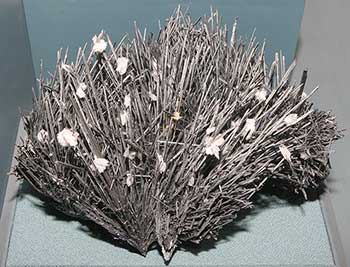 |
| Stibnite - Sb2S3. |
Antimony is a silvery-gray, brittle semi-metal with atomic number 51. It rarely occurs in nature as a native element, but is found in a number of different minerals, the most important of which is stibnite (SbS3). Antimony is often called a semi-metal, because in pure form it is not shiny and malleable like true metals. Antimony is mined as a principal product or as a byproduct of the smelting of base-metal ores in 15 countries, which includes the United States (Montana, New Jersey, and Texas). China is the world's major producer followed by Russia and South Africa. Antimony is used principally for flame retardants as well as in ammunition and automotive batteries and as a decolorizing agent in glassmaking.
Antimony is not an element which most people see daily in a recognizable form. However, it is present in many products in everyday use. Antimony's moderate price allows it to be used in a wide variety of applications.
Antimony minerals, particularly stibnite, have been known and used since ancient times. Because it is so soft, stibnite was used in ancient times as black eye makeup. The Roman historian, Pliny, wrote about its use as a medicine. Artists used finely-ground stibnite in the Middle Ages as a black pigment. Ancient "scientists" were interested in antimony because of their belief that it may be useful in the process of changing common metals into gold. This field was known as alchemy.
Name
The ancients may have occasionally produced pure antimony from its ore stibnite, and medieval alchemists have left recipes for preparation of the pure metal. However, it was not actually recognized as a separate element until the mid-1400's, when chemistry as a science began to take shape. The French chemist, Nicolas Lemery, is known to have performed some of the earliest studies on antimony.
The name antimony is derived from the Greek words anti and monos, which together mean not alone, because it rarely occurs naturally in pure form. Its chemical symbol, Sb, is derived from the Latin word stibium, which was the name of the most common antimony mineral, stibnite.
Sources
Antimony rarely occurs in its native metallic form in nature. It easily combines with other elements, usually including sulfur, to form over 100 different minerals. Of these minerals, only stibnite (SbS3) is mined commercially as a source for metallic antimony. Antimony is found in trace (that is, very minor) amounts in silver, copper and lead ores, and it is usually economically possible, as well as environmentally desirable, to extract the antimony from these ores when they are smelted.
Most of the antimony mined each year comes from China, which supplies over three-quarters of the world total. The remainder is from Russia, South Africa, Tajikistan, Bolivia, and a few other countries. Some antimony is produced as a by-product of smelting ores of other metals, mainly gold, copper and silver, in countries such as the United States, Canada, and Australia.
No mines are currently producing antimony ore in the U.S., but important amounts are yielded as a by-product of copper and silver mining. Numerous stibnite deposits occur in Idaho, Montana and Nevada, but most are worked out. Recycling of old lead-acid batteries (such as automobile batteries) contributes to U.S. antimony production.
Uses
The most important use of antimony in the United States is in chemicals used to impregnate plastics, textiles, rubber, and other materials as a flame retardant - that is, a form of fireproofing. This is required by federal law for certain children's clothing. Over half the annual U.S. antimony consumption is for the manufacture of flame retardants.
A portion of U.S. consumption is in antimony alloys. Antimony is mixed (that is, alloyed) with other metals, such as lead, to make the lead harder and stronger for use in lead-acid batteries. On the other hand, some alloys such as Babbitt Metal (an alloy of antimony, tin, copper, and sometimes lead) are useful as machine bearings because they are soft and slippery. Antimony is also alloyed with tin to make pewter items such as plates, pitchers and cups, used mostly for decoration. One use of antimony, which is declining, is to make type metal for printing newspapers and magazines. Antimony is one of very few substances (bismuth and water are two others) which expands when it cools and freezes. Antimony-bearing type metal thus fills every corner of a mold used to prepare sharp type for printing. With the advent of computer printing, this use has greatly decreased.
Antimony is also used for pigments in plastics, paints, rubber, and for a wide variety of minor uses, including medicines, fireworks, and others. Antimony oxide is a brilliant yellow color, accounting for much of the pigment use.
A tiny amount of highly purified antimony metal is used in the computer industry to make semiconductors. To be useful in this application, antimony has to be 99.999% pure!
Substitutes
Antimony could be replaced by chromium, tin, zinc, and titanium compounds in the paint industry. Cadmium, sulfur, copper, and calcium can be used to harden lead. A number of organic compounds can be used as fire retardants. Recycling, mining, and smelter production will meet the demand for antimony and antimony compounds for many decades to come.